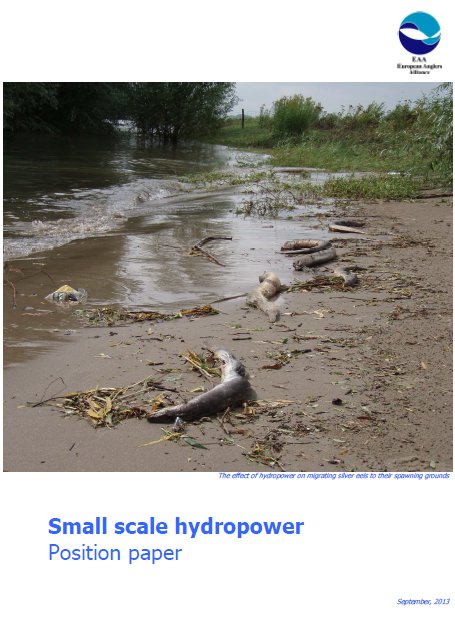EAA position on small scale hydropower
General effects of hydropower generation

Hydropower generation has a welldocumented impact on water ecosystems. It affects the hydrology and changes the flow and temperature regime of the water environment, it affects the oxygen content of water and can have a major impact on the micro and macro flora and fauna of the affected river system. Hydropower creates both upstream and downstream migration barriers that severely affect fish and other aquatic fauna. In some cases streams and rivers can be completely drained or dammed which means a total destruction of the affected habitat.
Fish passing through turbines will often be injured or killed and this risk increases exponentially with increasing body size and length of fish. The European eel is an example of a species heavily affected by hydropower and it now faces extinction. Nearly all fish species are severely affected by hydropower because they have to migrate to complete their lifecycle. Hydropower generation also affects recreational angling, tourism and other forms of water based recreation.
Small scale hydropower
Small scale hydropower plants, normally considered as smaller than 10 megawatts output, are problematic for several reasons. Small scale hydro plants have a low economic return, but are very damaging to the environment. In many cases, development is only viable because of government subsidies for construction or to pay for the power generated.
Subsidised development with a small economic return means that very little funding is available to reduce the environmental impacts of new or current hydro development. A common problem with small hydropower plants is the lack of proper action to minimise environmental impacts using fish screens or by failing to set minimum flow regimes for the water remaining in the river.
In many cases there are no regulations or environmental guidelines in place for the operation of plants. This means that the environmental cost is very high compared to the economic benefit of electricity generation. Added to these problems is the fact that in many cases/countries aquatic biodiversity, and particularly essential spawning areas for migratory fish, are concentrated in smaller rivers which are now being targeted by small scale hydro developers.
What the EAA wants:
- Member States to create ‘No Go’ areas for all hydropower on pristine river systems e.g. Alpine areas and Natura 2000 sites.
- No new weirs for the development of small scale hydropower stations and flow turbines (run of the river).
- Remove public subsidies for small scale hydropower plants.
- Upgrade existing small scale hydropower plants to avoid any impact on ecological status to comply with Water Framework Directive (WFD) by improving fish passage for up- and downstream migration.
- Create regulations and conditions for minimum or ecological flow and for minimising oscillating flow.
- Remove local small scale hydropower plants/barriers to river continuity where biodiversity and recreational amenity value are being damaged
Why?
Electricity generation capacity from new small scale hydropower plants is a tiny fraction of national electricity output, but
very damaging to the environment. Economic subsidies for the creation of small scale hydropower increases pressure on the last few remaining free flowing rivers and rapids. These areas have large and intrinsic value as places of biological diversity and for the recreational value they offer. Building of small scale hydro-power prevents the positive development of recreational angling and related tourism and other forms of water based recreation, and local
communities experience negative environmental consequences. Communities benefit from minimal new energy generation.
Furthermore the building of new small scale hydro-power is in direct conflict with the EU Water Framework Directive (WFD). The WFD requires that waters to achieve good ecological status, and for there to be no deterioration in the condition of water environments. A dammed river in effect means that the potential attraction of that area for tourism and recreation is severely hampered and perhaps lost forever. The last free flowing unrestricted waters in Europe are essential for several forms of water-based recreation and should be utilised to create possibilities for sustainable economic development via tourism and regional employment opportunities.
The European Anglers Alliance (EAA) fully supports Member States’ commitments to increase the amount of energy produced from renewable sources as detailed in the Renewable Energy Directive (2009/28/EC) and in doing so decrease greenhouse emissions to mitigate against present and future climate change impacts. However we are increasingly concerned about the increased focus on hydropower as a means to meet these targets given the accepted adverse affects on the aquatic environment and the risk of failing to meet the Water Framework Directive (2000/60/) targets of all water bodies reaching good ecological status or good ecological potential by 2015. This is particularly important as hydropower and dams have been identified as being highly damaging to water bodies but generate small amounts of power.
Hydropower Generation in the context of the EU Water Framework Directive
- “Broodstock can be prevented from reaching their spawning grounds during the breeding seasons, resulting in massive failure of recruitment and eventual extinction of the stock above the dam.” (page 79)
The report makes it clear that the contribution from small hydropower (<10 MW output) to renewable targets is insignificant and environmentally damaging. The report goes on to recommend that Member States should focus on the development or refurbishment of large power plants with an output larger than 10 MW as additional capacities are available by an improved use of existing plants and upgrading the environmental mitigation measures on these plants. As the report warns: “New constructions will not only have impacts on the environment (upsurge operation) but also face social resistance” (page 12).
September 2013
For notes and references please download the position paper
Downloads: